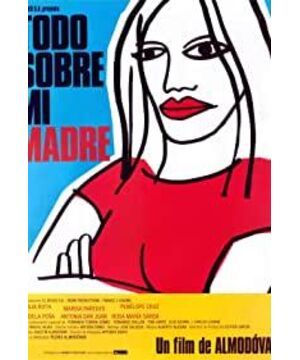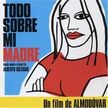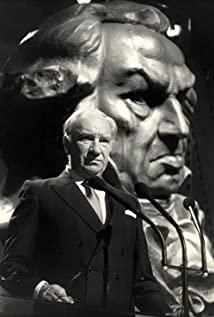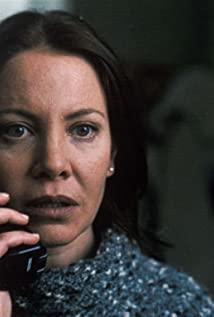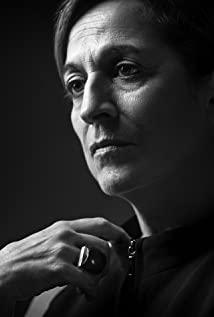http://www.mtime.com/my/mnauce/blog/565726/1
. Almodovar's most notable style is naturally bright and charming colors. Almodovar's films are almost all eye-candy, especially for indoor scenes. The scenery and colors are very elegant. This style mainly comes from the influence of Pop art and Douglas Sirk. Sirk's influence is also reflected in the melodramatic tendency of some of his works.
The main color of this film can be considered to be red, blue and yellow. This combination was established at the beginning of the film. After that, this color coding is also seen everywhere, including the color of the coat. The door of the organ transplant room is also red and blue with a white background. . (In addition, AAMM is also the last part of Almodovar's so-called blue trilogy, relative to the previous "rose films")
Costume and makeup are also compatible with color. Generally, Almodovar likes high contrast color/costume/makeup and even acting style. In this film, Manuela is a more natural performance style, basically without makeup (according to Almodovar's own statement, it belongs to Swedish performance style), while Huma and Lola's costumes and makeup are quite stylized, and Agrado is not only stylized (first very punk) Red leather outfit, changed to casual clothes when I returned home, and finally went out in a Chanel-similar to Victoria Abril's Chanel in the High Heels), the performance style is also the most exaggerated. And Almodovar consciously uses costume, makeup and even cosmetics (plastic surgery) as its narrative content (this is also the usual method of some modern filmmakers), such as the aforementioned Chanel and Sister Rosa's claim: "Prada is perfect for nuns"; Agrado She even tells the story of her plastic surgery on stage; Huma's dressing room is an important interior of the film. . .
2. In addition to color, Almodovar's tendency to form is also very eye-catching. In particular, almost all of his film narratives are full of sense of form, especially the early Matador and recent films.
Let me talk about the
1) allusion
i) All About Eve, first of all it is the allusion of the title. The allusion in the plot, such as Manuela, was like Eve Harrington, who was a fan at first, and then succeeded as a substitute, and then it was like the plot of his son asking for an autograph. (As mentioned by senior sister honeykop, the plot of the car accident after rainy night is more like Opening Night, considering that Gena Rowlands is included in the list at the end of the film, John Cassavetes is also a director who has a considerable influence on Almodovar, and there is no doubt to pay tribute to Opening Night. .)
ii) A Streetcar Called Desire, Manuela said "A Streetcar Called Desire marked my life". She met her husband through this play, and the death of her son is also related to this play. The film also quoted Blanche’s famous quote: Whoever you are, I have always depended on the kindness of strangers.
iii) If you look closely at the poster on the wall of A Streetcar Called Desire, you will find grainy patterns, which belong to waves. Mosaic style in popular art. Comrade Almodovar, as a representative of the La Movida movement, Andy Warhol of Spain, his early works are more popular, but now only these remnants remain. . .
2) repetition
In fact, it is also one of the important characteristics of Pop Art. Almodovar's narrative shows a lot of repetition. The beginning of the film was the hospital scene, and the organ transplant seminar that Mauela participated in afterwards was also a rehearsal of the incident after his son was hit by a car. Also transplanted)-Of course, this scene actually also repeats Almodovar's previous work The Flower of My Secret. In addition, what happened to Rosa later reproduced Manuela's experience to a large extent. This has to be mentioned
3) Substition/projection
is a common feature of Almodovar since this film. After Rosa's death, Manuela took the place of her to raise Rosa and Lola's son, whose name was also Esteban (the same name as his father and deceased brother). Talk to Her repeated this model to a large extent. Marco replaced Benigno to complete the relationship between Alicia and the latter. The same. Talk to Her is similar to this film in many aspects, such as the four-shot, and the role of modern dance at both ends of the film is equivalent to the role of All About Eve and Streetcar in AAMM.) And In Bad Education, his younger brother Juan replaced his elder brother Ignacio. I continue to talk about
4) allusion to early Almodovar Films.
As mentioned earlier, the film itself is developed from a short section in The Flower of My Secret (just like Matador is developed from an element in Labyrinth of Passions).
The whole film basically uses high key lighting, but the low key tone is obviously used in the two scenes. One is the cruising for sex after Manuela just arrived in Barcelona, responding to the opening scene of Labyrinth of Passions and a section of Live Flesh. . There is also a crusing for drug response to Tie Me Up! A passage from Tie Me Down. The two cruising sections are not only similar in lighting, but also similar in background music.
3. Almodovar likes to use a two-shot. Almost two-shot dialogues are used in this film. The only special case I noticed is that Rosa told Manuela that she was HIV positive. This scene started out as a general Hollywood-style front and back fight. The two reached an understanding after arguing/defense, and finally hugged each other in a two-shot. In Almodovar's recent six or seven works, two-shot has been used quite frequently, and it is compatible with its shallow space/lateral staging and frontality. These are of course also related to the use of widescreen (aspect ratio=2.35:1). Personally, I understand that widescreen is more suitable to express the symmetry of composition that Almodovar likes, so the two-shot/lateral staging is very understandable. Lateral staging can also have multiple performance areas, which is equivalent to turning the depth staging to the horizontal direction.
4. In photography, Almodovar prefers to start a paragraph with panning.
5. Motif
Photo/Poster is the main motif of this film, and Photo is also the prop of the same sex. We saw a large number of photos posted in Huma's dressing room, including photos of Bette Davis. In one shot, there was a picture of Bette smoking first and then racking focus. The screen showed a shot of Huma smoking in the close range, suggesting that Huma was Bette’s Projection. The photo is still the motif of the past time/people. The main story of the film actually started with the son's pursuit of the incomplete photo (the theme of finding the father, which is also expressed in Rosa). At the end of the film, when the three women got together, the photo of the son was added to the photos in Huma's dressing room and became a member of the beloved people. Here)
train/tunnel (time shuttle) is also used as the time motif.
6. Feminism is of
course a big topic, so I won’t discuss it this time. I only quote one sentence from the film
women will do anything to avoid being alone.
7. Other shots in the film that I have a deep impression on
1) The subjective shot of my son being knocked down by a car
2) After Rosa explained the important words to Manuela before his death, the camera pans to the window on one side, the window frame is cross-shaped, and then the next one Camera, the cross on the top of the church, Rosa's funeral.
8. Although this film is very popular, I think it can only be regarded as Almodovar's upper-middle level work. In fact, Talk To Her, a post-production refinement based on this film, is more artistically appealing than this film.
View more about All About My Mother reviews


